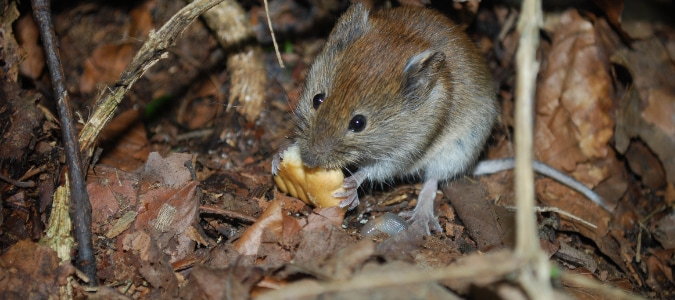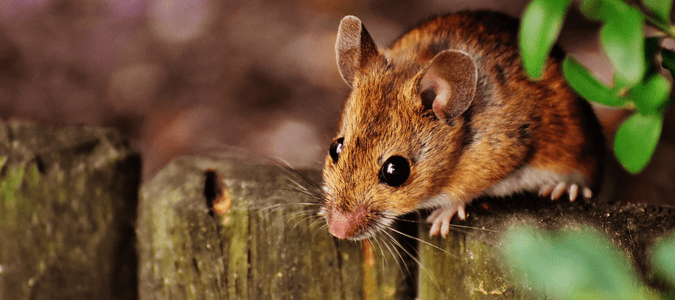So you’ve found mouse droppings, gnaw marks on your furniture, cardboard boxes and plastic storage bins that have been chewed through and other signs that point to the presence of mice in your home. Maybe you’ve even seen an actual mouse somewhere inside your house, or at least heard the telltale scratching and squeaking sounds of rodent activity within your walls.
Whatever signs you’ve spotted, something has alerted you to the possibility that mice are living in your home, and now you’re wondering whether you’ve got just one or two of the unwanted little rodent pests or a full-blown infestation. How many mice is considered an infestation? It’s a good question to ask, as the answer will inform you as to the scope of your mouse problem and what you need to do next.
The question “How many mice is considered an infestation?” is a bit complicated to answer. If you have just one or two mice that have come indoors in search of food or shelter, that does not constitute an infestation, but the problem should be addressed before it grows into one. If you have mice that build a nest somewhere inside your home, however, that’s an even bigger problem, and it could be considered an actual infestation.
How Fast Mice Breed
Consider this: A female mouse usually has anywhere from five to twelve babies in one litter, and she can have between five and ten litters a year. Worst of all, mice can start breeding at just 8 to 12 weeks old and will keep reproducing until they die. If you do the math, you can see how quickly just a few mice in your home can turn into a big problem!
It can be very difficult for the average homeowner to tell if the one mouse you have spotted has or will build a nest in your home, so your best bet is to take any steps you can to keep that from happening so you don’t have to deal with a full-blown infestation. A pest control specialist can help you control these pests before they turn into an even bigger issue.
To do that, let’s learn a little more about these small, furry creatures, including why they are an unwelcome presence inside your home or garage, and how exactly they might be getting into your living spaces.
Why Do I Have Mice In My House?
If you suspect you have mice living in your home—happily munching through the food in your pantry, feeding on the water and kibble you leave out for your pets and even nesting and having babies—you’ll probably wonder why these little creatures have taken up residence where they definitely aren’t welcome. Especially if you keep your home clean and store your food in the proper areas, it can be hard to fathom how you could still have a mouse problem.
And make no mistake: Mice might be tiny, furry and even arguably cute, but they are a real problem when they move into your living quarters. They present a variety of health and safety concerns for both humans and pets, and they can do a lot of damage to a home over time. Mice, like other rodents, have long front teeth that continue growing throughout their lives, making it necessary for them to gnaw regularly to keep the teeth filed down. That gnawing behavior can lead mice to damage furniture, boxes and other possessions, or even the structure of your home, as they satisfy their urge to chew. Their gnawing has even been known to cause fire hazards when they chew on electrical wiring.
Diseases Mice Carry
Mice also carry diseases like hantavirus and salmonella that can make people very ill, and they can be an indirect source of health issues for humans. For example, any fleas or ticks that live on a wild mouse as their host have the capability of transmitting Lyme disease or other insect-borne illnesses to humans—and that’s leaving aside the fact that an indoor flea or tick infestation is an annoying problem in itself.
For all these reasons and more, if you spot signs that indicate the presence of mice, you might wonder, “Why do I have mice in my house?” Living in a home with a mouse problem can seem embarrassing, but it shouldn’t. If it’s cold outside, food and water sources are scarce, and mice are able to gain access to the indoors, they will be more than happy to move in, no matter how clean and orderly you keep your home. And if they find a warm, protected spot where they can set up a nest and breed, then you could have a mouse infestation on your hands in no time. The best course of action is to reach out to a pest control professional for help. They know what mice hate and how to deter them.
How To Find Mice Entry Points
The most effective way of dealing with mice in your home is preventing them from being there in the first place. This involves a twofold approach: First, you’ll have to find all entry points and close them off so mice and other small rodents can’t get in, and second, you’ll need to make sure your home is not an appealing source of food, water or shelter—the three elements mice are seeking if they do happen to make it inside your house.
To find mice entry points, it’s important to carefully inspect your home’s foundation and the areas around windows and doors. Indoors, look inside cabinets, under shelves, along baseboards and behind furniture. If you spot any holes or gaps either inside or outside the home, seal them off, preferably with steel wool or copper mesh, followed by caulk, so the mice can’t chew their way through. A professional will know how to get rid of mice outdoors. Install fresh weather-stripping around windows and doors, if needed, to ensure a tight seal on all sides. Remember that mice can squeeze through spaces as small as a dime, so don’t take any chances; seal off anything that looks remotely possible for mice to get through.
Once you’ve found and sealed off all the entry points that mice may be using to access the interior of your home, it’s time to make the inside of your home less appealing to hungry rodents. This involves keeping your kitchen clean, storing both human and pet foods in airtight, well-sealed containers and keeping your home free of clutter. Generally, you want to make sure that even if a mouse were to find its way indoors, it wouldn’t have an easy time of making a home for itself.
How To Find Where Mice Are Coming Into A House
Mice can be innovative in getting access to your home. They can sometimes access people’s homes by climbing down their chimneys. Installing sheet metal around the base of the chimney will prevent this problem. Make sure it’s at least a foot wide, to ensure that mice can’t get above it.
Since mice can enter homes through cracks and holes quickly, it’s important to stay vigilant in looking for cracks. Most adult mice only need an opening that is a quarter inch in diameter to fit through to make their entrance.
You can also look at any spots where utility lines enter the exterior walls of your home. Use silicone caulk to seal off any gaps that might exist between the lines and your home’s siding, brick or other material. Vents and duct openings are another place that might have gaps wide enough for mice to squeeze through. Steel wool, wire mesh or caulk should be effective in keeping them out.
Signs Of Mice In A Bedroom
Having a mouse in your garage is one thing. Suspecting there may be a rodent where you sleep is an entirely different matter. That said, the signs of mice in your sleeping quarters are largely the same as signs of mice activity in any area of the home or garage. Telltale signs that point to a mouse infestation include:
- Mouse droppings, which are dark-brown pellets with pointed ends, no more than a quarter-inch in length
- Scratching or squeaking sounds coming from inside the walls, ceiling or ductwork
- Gnaw marks on baseboards, furniture, electrical wiring, drywall or anywhere else
- An ammonia-like smell that might be mouse urine
- Holes or gaps in corners, cabinets, baseboards or elsewhere, which mice could be using as a pass-through to access inside the walls or other areas
- Nesting materials, such as bits of cloth, cotton, fiberglass, shredded paper or cardboard, or any other similar items
Deterring Mice
If you see any of the above in your bedroom area, it could indicate that mice are living nearby, and it’s time to take steps to control them.
If you have just a few mice that have entered your home, your problem may be a simple one to address. The problem is, if mice have gotten into your home, it’s rarely just one or two of them. Mice are prolific breeders. Besides, the fact that even one mouse came indoors means two things. First, it means they had a reason to come indoors in the first place (usually a lack of food, water or shelter outdoors, in their natural habitat). Second, it means they were able to access the indoors with ease. A pest control specialist can address a rodent infestation.
ABC Can Handle Your Mouse Problem
If you spot mouse droppings, nesting materials, gnaw marks and other signs that point toward mice living in your home, it almost certainly means you have a mouse infestation. That requires a more far-reaching solution than just a few strategically placed traps. Not sure how to get rid of rodents? The pest control specialists at ABC Home & Commercial Services can develop a comprehensive plan to help in controlling rodents. Our specialists can control your mouse problem with a combination of several possible strategies.





